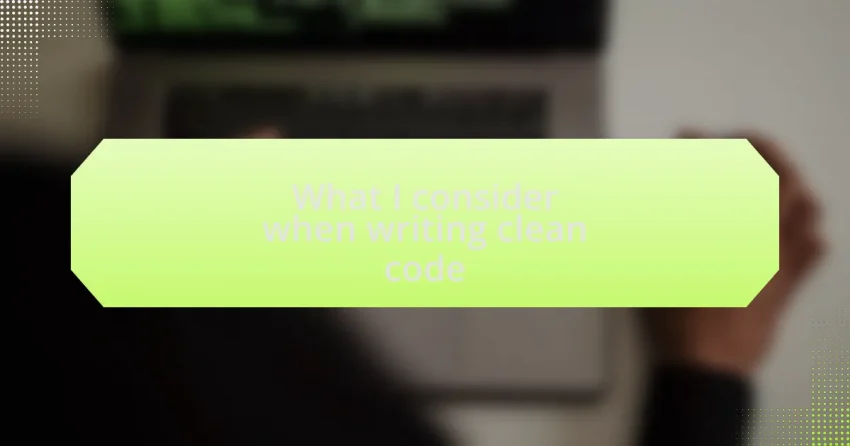Key takeaways:
- Clean code principles emphasize readability, maintainability, and simplicity, making code self-explanatory.
- Key characteristics include simplicity, readability with shorter functions, and thorough documentation to enhance understanding.
- Tools like linters and code formatters (e.g., Prettier) improve code quality and team collaboration, while version control (e.g., Git) aids in managing code changes effectively.
Author: Lydia Harrington
Bio: Lydia Harrington is an acclaimed author known for her captivating storytelling and rich character development. With a background in literature and a passion for exploring the complexities of human relationships, Lydia’s work spans multiple genres, including contemporary fiction and historical romance. Her debut novel, “Whispers of the Heart,” won the prestigious Bellevue Literary Prize, and her subsequent works have garnered critical acclaim and a loyal readership. When she’s not writing, Lydia enjoys hiking in the mountains and hosting book clubs, where she delights in sharing her love for literature. She currently resides in Portland, Oregon, with her two rescue dogs.
Understanding clean code principles
Clean code principles hinge on readability, maintainability, and simplicity. I remember the first time I took over a project with convoluted code—it was like trying to decipher an ancient language. It made me wonder: how often do we sacrifice clarity for cleverness?
One key principle is that clean code should be self-explanatory. When I write, I aim for someone unfamiliar with my thought process to pick up my code and feel its intentions. I often think about how gratifying it is to look back at cleanly structured code; it feels like a proud moment when my peers can follow my logic without a hitch.
Another aspect I consider vital is consistency in naming conventions and structure. I once attended a seminar where an experienced developer stressed that naming is not just about labels; it’s about creating a narrative. This insight resonated with me deeply—our code tells a story, and if that story lacks coherence, it can lead to misunderstandings down the line. Wouldn’t you agree that a well-told narrative makes every chapter easier to follow?
Key characteristics of clean code
One of the key characteristics of clean code is its simplicity. I recall a project where I introduced a feature that seemed straightforward but ended up convoluted, leading to countless revisions. It made me realize that simplicity not only enhances comprehension but also reduces the chances of bugs sneaking in. Have you ever found yourself tangled in complex code? Simplifying my approach often leads to more elegant solutions.
Readability is another critical attribute I cherish. I remember an instance when a colleague struggled to understand my logic due to dense functions with nested loops. It was embarrassing and a bit humbling, pushing me to prioritize clarity. I now strive to use shorter functions with clear purpose, making it easier for anyone to jump in without feeling overwhelmed. Isn’t it rewarding when someone else can easily grasp your work?
Lastly, proper documentation is something I hold in high regard. I’ve seen developers neglect commenting, only to create a headache for others down the line. I learned the hard way that a simple note about the intention behind the code can save hours of detective work later. How often do you find yourself flipping through the code trying to remember why a particular decision was made? Documentation transforms those moments of confusion into clarity, bridging gaps for anyone who revisits the code.
Tools to maintain clean code
When it comes to maintaining clean code, I find that using tools like linters is invaluable. I vividly remember working on a large JavaScript project and overlooking some minor syntax errors that a linter could have easily caught. It felt frustrating to debug issues that could’ve been avoided with a simple run of ESLint. Have you ever spent hours hunting for a bug, only to realize it was a tiny typo? Linters can automate those checks, allowing you to focus on more important aspects of your code.
Another handy tool in my arsenal is Prettier, a code formatter that enforces consistent style across my projects. I once joined a team where everyone had different coding styles, leading to a constant back-and-forth during code reviews. The moment we integrated Prettier, everything changed. It felt like a breath of fresh air to see code reviews smoothly transition from style debates to constructive feedback. Isn’t it amazing how a consistent format can enhance team collaboration?
Version control systems like Git are also essential for maintaining clean code. In my experience, using branches to isolate features has saved me countless headaches. I remember a time when I integrated changes directly into the main branch, which led to a chaotic mix of unfinished features. Now, I can experiment freely, knowing that if something breaks, I can easily revert back. Have you ever lost track of which changes were successful? A structured version control process is a lifesaver in those chaotic moments.
